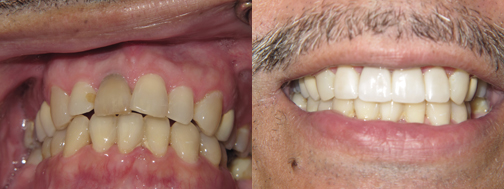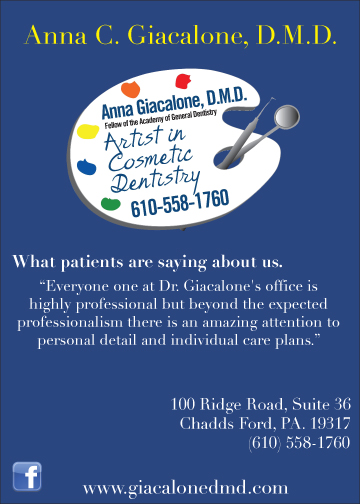The Single Dark Tooth

By Anna Giacalone, D.M.D.
Many adults are embarrassed by the appearance of a single dark front tooth. Most often the tooth was traumatized in their youth and needed to have a root canal. A blow to the face, a fall or auto accident may have either caused a tooth fracture exposing the nerve of the tooth (the pulp) or caused injury to the delicate blood vessels feeding the pulp. Either way the pulp dies.
The interior layer of the hard tissue of the tooth known as dentin is composed of multiple tiny tubules. When the pulp is injured there is bleeding into these tubules. The hemoglobin in the blood releases iron which forms a black compound when in the presence of hydrogen –sulfate. Another way the tooth becomes dark is from the proteins formed when the dying pulp tissue degrades.
Choice of treatment for the cosmetic problem depends upon the darkness of the shade, the length of time the tooth has been discolored, and the structural integrity of the tooth.
If there has been significant tooth structure lost from the original injury such as a fracture, or if there are large fillings in the tooth, a restorative solution is the best choice. This would involve fabricating a crown (cap). The crown would not only achieve color correction but also strengthen the tooth. In the case shown here I restored with crowns in addition to correcting the tooth position orthodontically.
When the tooth is sound, contours and position pleasing, a more conservative approach is preferred. Also we like to avoid permanent crowns on very young patients who are still growing. In these instances bleaching is the treatment of choice. Bleaching the endodontically treated tooth is more involved than the bleaching of an entire smile with which most people are familiar.
The degree of darkness plays a role as does the length of time the tooth has been discolored and the age of the patient. Obviously it is easier to achieve a corrective shade when the tooth is closer to the shade of adjacent teeth to begin with. The longer the tooth has been discolored, the harder it is to neutralize the stain causing factors in the tubules. Younger people have wide open tubules which allow better penetration of the bleaching materials. They tend to get better results in less time for this reason.
There are many techniques for bleaching the single dark tooth. Bleaching substances applied to only to the exterior of the tooth tend to have less success. Most protocols involve obtaining access to the interior of the tooth through the same channel used for the original root canal. Other protocols employ both an internal and external application of the bleaching agent. One of the most favored internal bleaching techniques is commonly known as Walking Bleaching. In walking bleaching, a paste of 3% hydrogen peroxide and sodium perborate is placed in the interior of the tooth where bleaching occurs while the patient caries on their daily activities. The material is refreshed at weekly intervals until the desired result is achieved.
There are some drawbacks to bleaching the endodontically treated tooth. One is that it is not always possible to achieve the desired result. Even when the result is achieved regression is a problem. That is, the tooth darkens over time. The degree and speed of regression is not predictable. The literature reports an initial success rate from 72-90%. Regression has been reported to be as high as 45%. In addition to disappointment with color correction, a more serious complication has been reported. Due to the toxicity of some bleaching solutions to the root and ligament of the tooth, erosion of the these structures, known as external resorption ,can occur. Usually this is seen when the stronger bleaching agents are employed.
It is possible to make a single dark tooth blend beautifully in your smile. Allow us to help you arrive at the best care plan to do just that.

What patients are saying about us:
“Have had significant dental and cosmetic work done by Dr. G. and she truly is an artist. Excellent skills, combined with a personable, focused, and caring manner will keep us using Dr. G. for a long, long, time.” – Tiffany V.
“I have been going to Dr. Giacalone for over 21 yrs. and I could not be happier with the service over the years. You always feel like a valued patient and treated very professionally,” – George C.
Anna C. Giacalone, DMD
Fellow of the Academy of General Dentistry
Education:
• BS. Biology Chestnut Hill College
• DMD. University of Pennsylvania School of Dental Medicine
• Certificate and Internship: Comprehensive Orthodontic Institute
• Certificate: prestigious Dawson Academy of Advanced Study
Awards:
• Pennsylvania Dental Association Award for Excellence during the four years of dental school
• Top Cosmetic Dentist Main Line 2007, 2011, 20012, 2013 (chosen by peers)
• Top Dentist in Delaware Valley, 2008; Delaware Valley Consumer Checkbook (chosen by patients)
• America’s Top Dentists 2010 – 2013 Consumer Research Counsel
To learn more visit her web site: www.giacalonedmd.com


